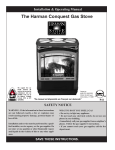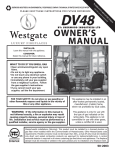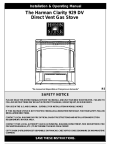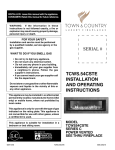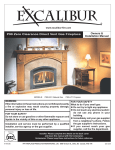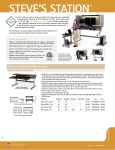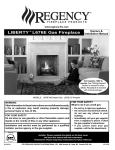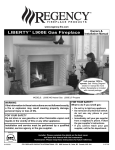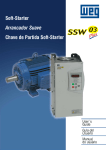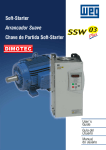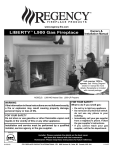Download Westgate DV48 Owner`s manual
Transcript
SHERWOOD INDUSTRIES IS AN ENVIRONMENTALLY RESPONSIBLE COMPANY. THIS MANUAL IS PRINTED ON RECYCLED PAPER. PLEASE KEEP THESE INSTRUCTIONS FOR FUTURE REFERENCE DV48 BY: SHERWOOD INDUSTRIES LTD OWNER’S MANUAL INSTALLER: Leave this manual with the appliance. CONSUMER: Retain this manual for future reference. WHAT TO DO IF YOU SMELL GAS • Open windows/extinguish any open flame. • Do not try to light any appliance. • Do not touch any electrical switch or use any phone in your building. • Immediately call your gas supplier from a neighbour’s phone. Follow the gas supplier’s instructions. • If you cannot reach your gas supplier, call the fire department. FOR YOUR SAFETY: Do not store or use gasoline or other flammable vapours and liquids in the vicinity of this or any other appliance. This appliance may be installed in an after-market permanently located, manufactured (mobile) home, where not prohibited by local codes. WARNING: If the information in this manual is not followed exactly, a fire or explosion may result causing property damage, personal injury or loss of life. Installation and service must be performed by a qualified installer, service agency or the gas supplier. This appliance is only for use with the type of gas indicated on the rating plate. This appliance is not convertible for use with other gases, unless a certified kit is used. Massachusetts installations (Warning): This product must be installed by a licensed plumber or gas fitter when installed within the Commonwealth of Massachusetts. Other Massachusetts code requirements: Flexible connector must not be longer than 36in., a shut off valve must be installed; only direct vent sealed combustion products are approved for bedrooms/bathrooms. A carbon monoxide detector is required in all rooms containing gas fired direct vent appliances. The fireplace damper must be removed or welded in the open position prior to installation of a fireplace insert. 50-2003 SAFETY PRECAUTIONS FOR SAFE INSTALLATION AND OPERATION OF YOUR “WESTGATE” HEATER, PLEASE CAREFULLY READ THE FOLLOWING INFORMATION: • All Westgate gas-fired appliances must be installed in accordance with their instructions. Carefully read all the instructions in this manual first. Consult the building authority having jurisdiction to determine the need for a permit prior to commencing the installation. • NOTE: Failure to follow these instructions could cause a malfunction of the fireplace, which could result in death, serious bodily injury, and/or property damage. • Failure to follow these instructions may also void your fire insurance and/or warranty. GENERAL • Installation and repair should be done by a qualified service person. The appliance should be inspected before the first use and, at least, annually by a qualified service person. More frequent cleaning may be required due to excessive lint from carpeting, bedding material, etc. It is imperative the control compartments, burners and circulating air passageways of the appliance be kept clean. • Due to high temperatures, the appliance should be located out of high traffic areas and away from furniture and draperies. Children and adults should be alerted to the hazards of high surface temperatures and should stay away to avoid burn or clothing ignition. • Young children should be carefully supervised when in the same room as the appliance. • Clothing or other flammable materials should not be placed on or near the appliance. FOR YOUR SAFETY • Installation and service must be performed by a qualified installer, service agency or gas supplier. • This installation must conform to local codes or, in the absence of local codes, to the current CAN/ CGA-B149 installation code (Canada) or National Fuel Gas Code ANSI Z223.1.2 (USA) 2 • To prevent injury, do not allow anyone who is unfamiliar with the stove to operate it. • To prevent injury, if the pilot or pilot and burners have gone out on their own, open the glass door and wait 5 minutes to air out before attempting to re-light the stove. • Always keep the area around these appliances clear of combustible material, gasoline and other flammable liquids and vapours. • These appliances should not be used as a drying rack for clothing or for hanging Christmas stockings/decorations. • Due to the paint curing on the stove, a faint odor and slight smoking will likely be noticed when the stove is first used. Open a window until the smoking stops. Always connect this gas stove to a vent system and vent to the outside of the building envelope. Never vent to another room or inside the building. Make sure the specified vent pipe is used, properly sized and of adequate height to provide sufficient draft. Inspect the venting system annually for blockage and signs of deterioration. WARNING: Failure to position the parts in accordance with the diagrams in this booklet, or failure to use only parts specifically approved with this appliance, may result in property damage or personal injury. WARNING: Do not operate with the glass front removed, cracked or broken. Replacement of the glass should be done by a licensed or qualified service person. • Never use solid fuels such as wood, paper, cardboard, coal, or any flammable liquids, etc., in this appliance. • Do not use this heater if any part has been under water. Immediately call a qualified service technician to inspect the heater and to replace any part of the control or gas control systems that have been under water. • Do not abuse the glass by striking it or slamming the door shut. TABLE OF CONTENTS Safety Precautions..........................................................................................2 Table of Contents...........................................................................................3 Codes And Approvals......................................................................................5 Specifications.................................................................................................6 Dimensions.........................................................................................6 Rating Label Location...........................................................................6 Rating Label........................................................................................7 Planning Your Installation................................................................................8 Introduction........................................................................................8 Non-Combustible Material Zone............................................................8 Typical Framing - Internal Chase...........................................................9 Typical Framing - External Chase.........................................................10 Typical Framing - Corner.....................................................................11 Typical Framing - Sidewall and Mantel.................................................12 Typical Framing - Raised Hearth..........................................................13 Installation of Fireplace Facing............................................................14 Installation of Optional Facing Trim......................................................15 Installation of Receiver.......................................................................16 Allowable Vent Configurations.............................................................16 Vent Termination Restrictions..............................................................18 Approved Vent Parts...........................................................................19 Installation of Flue Restrictor...............................................................20 TV Installation Above Unit..................................................................21 Installation Set-Up........................................................................................22 Planning Your Installation...................................................................22 Assembly of the Unit..........................................................................22 Securing unit into Position..................................................................22 Installation Of Non-combustible Wall And Hearth Board........................23 Installation Of Venting And Terminations.............................................23 Horizontal Installation........................................................................24 Vertical Termination Installation..........................................................26 Door Removal and Installation............................................................28 Electrical Hook-Up..............................................................................29 Gas Hook-Up.....................................................................................30 LP Gas Conversion.............................................................................30 Firebox Liner Installation....................................................................32 Log Burner / Ember Bed Installation....................................................34 Log Set Installation............................................................................35 Glass Burner Installation.....................................................................37 Porcelain Panel Kit Installation............................................................39 Optional Front Installation..................................................................41 3 TABLE OF CONTENTS Start-Up & Operation....................................................................................43 Normal Sounds During Operation.......................................................43 Remote Control Operations................................................................43 Technical Data...................................................................................43 System Description............................................................................44 Wall Mounting The Receiver.................................................................45 Operating Procedure..........................................................................45 Air Shutter Adjustment.......................................................................48 Check for Proper Burner Flame...........................................................49 Service / Maintenance..................................................................................50 Lighting Instruction Label..................................................................50 Light Bulb Replacement......................................................................51 Cleaning / Annual Service..................................................................51 Cleaning The Glass............................................................................51 Replacing Glass.................................................................................51 Wiring Harness.............................................................................................52 Troubleshooting..........................................................................................53 Parts List.....................................................................................................55 Parts Diagram...............................................................................................56 Warranty......................................................................................................57 Notes.............................. ...............................................................59 Installation Data Sheet..................................................................................60 4 CODES AND APPROVALS DIRECT VENT ONLY: This type is identified by the prefix DV. This appliance draws all of its air for combustion from outside the dwelling, through a specially designed vent pipe system. This appliance has been tested and approved for installations from 0 feet to 4500 feet (1372 m) above sea level. In the USA: The appliance may be installed at higher altitudes. Please refer to your American Gas Association guidelines which state: the sea level rated input of Gas Designed Appliances installed at elevations above 2000 (610 m) feet is to be reduced 4% for each 1000 feet (305 m) above sea level. Refer also to local authorities or codes which have jurisdiction in your area regarding the de-rate guidelines. In Canada: When the appliance is installed at elevations above 4500 feet (1372 m), the certified high altitude rating shall be reduced at the rate of 4% for each additional 1000 feet (305 m). • This appliance has been tested by INTERTEK (Warnock Hersey) and found to comply with the established VENTED GAS FIREPLACE HEATER standards in CANADA and the USA as follows: VENTED GAS FIREPLACE HEATER (DV48; NG/LPG) TESTED TO: ANSI Z21.88a-2007/CSA 2.33a-2007 VENTED GAS FIREPLACE HEATERS CAN/CGA 2.17-M91 GAS FIRED APPLIANCES FOR HIGH ALTITUDES CSA P.4.1-02 TESTING METHOD FOR MEASURING ANNUAL FIREPLACE EFFICIENCY This Westgate DV48 Fireplace: • Has been certified for use with either natural or propane gases. (See rating label.) • Is not for use with solid fuels. • Is approved for bedroom or bed sitting room. (IN CANADA: must be installed with a listed wall thermostat. IN USA: see current ANSI Z223.1 for installation instructions.) • Must be installed in accordance with local codes. If none exist, use current installation code CAN/CGA B149 in Canada or ANSI Z223.1/NFPA 54 in the USA. • Must be properly connected to an approved venting system and not connected to a chimney flue serving a separate solid-fuel burning appliance. IMPORTANT NOTICE (Regarding first fire up): When the unit is turned on for the first time, it should be turned onto high without the fan on for the first 4 hours. This will cure the paint, logs, gasket material and other products used in the manufacturing process. It is advisable to open a window or door, as the unit will start to smoke and can irritate some people. After the unit has gone through the first burn, turn the unit off including the pilot, let the unit get cold then remove the glass door and clean it with a good gas fireplace glass cleaner, available at your local WESTGATE dealer. 5 SPECIFICATIONS DIMENSIONS: ø8” (203mm) ø5”(127mm) 6 1/16” (154mm) 17 9/16” (446mm) To Gas Line Connection 20 5/16” (516mm) 36 13/16” (935mm) 44 5/8” (1133mm) 43” (1092mm) 52 1/4” (1327mm) 33 1/4” (845mm) 41 3/16” (1046mm) 39 11/16” (1008mm) 14 3/4” (375mm) 5 1/2” (140mm) To Gas Line Connection Figure 1. Dimensions of the Firebox. RATING LABEL LOCATION: The Rating and Lighting instruction label is located below the door frame, underneath the firebox attached to a chain. To access the label, slide the plate forward out from under the firebox. Always return it when finished. Figure 2. Rating/Lighting Label Location. 6 SPECIFICATIONS RATING LABEL: vere burns may result. Keep r other flammable vapors away. s removed, cracked or broken. nsed or qualified person! This be installed with provisions for operating instructions manual. n, service or maintenance can r to owner's manual provided g instructions accompanying by a qualified installer, service PERATING DO NOT REMOVE THIS LABEL / N'ENLEVEZ PAS CETTE ETIQUETTE DV48 WH- VENTED GAS FIREPLACE HEATER ENVIRO MODEL: FOYER AU GAZ A EVACUATION MODELE ENVIRO: DV48 NAT: (Gaz naturel) Certified for use in Canada & USA Certifié pour installation au Canada et aux Etats-Unis. WH# 16354 LPG (Propane) TESTED TO / TESTÉE SELON LES NORMES: ANSI Z21.88a-2007/CSA 2.33a-2007 VENTED GAS FIREPLACE HEATERS / FOYER AU GAZ EVACUATION; CAN/CGA 2.17-M91 GAS FIRED APPLIANCES FOR HIGH ALTITUDES / LES APPAREILS BRULANT GAZ POUR UTILISATION EN HAUTES ALTITUDES; Can/CSA P.4.1-02 (R2006) TESTING METHOD FOR MEASURING ANNUAL FIREPLACE EFFICIENCY / LA METHODE D'ESSAI POUR MESURER L'EFFICACITE DE CHEMINEE ANNUELLE. INPUT (ENTRÉE): NAT: 0-4500 FT (1372 M) EXACTLY, A FIRE OR EXPLOSION L INJURY OR LOSS OF LIFE. any portion of this appliance oes not operate as the instructions ndicate, don't try to repair it, call a ualified service technician. Do not se tools. Force or attempted repair may result in a fire or explosion. o not use this appliance if any art has been under water. mmediately call a qualified service echnician to inspect the appliance nd to replace any part of the ontrol system and any gas control which has been under water. NS 6. This appliance is equipped with a completely automatic ignition and lighting control. The control will attempt to light the pilot several timesif necessary. If it is unsuccessful, it will discontinue operations. If the appliance does not operate, follow the instructions "To Turn Off Gas To Appliance" and call your service technician or gas supplier. Blue LCD Display ON/OFF Key THERMOSTAT Key UP/DOWN Arrow Key MODE Key ANCE F" will be indicated on the display ommand has been received. C-11800 MAX: 48,000 BTU (14.07 KW•h) MIN: 16,000 BTU (4.68 KW•h) LPG: 0-4500 FT (1372 M) MAX: 48,000 BTU (14.07 KW•h) MIN: 17,000 BTU (4.98 KW•h) MANIFOLD PRESSURE (PRESSION D’ADMISSION): NAT: 3.5 in. WC (0.87kPa) / 1.6 in. WC (0.40kPa) LPG: 10 in. WC (2.48kPa) / 6.4 in. WC (1.59kPa) MINIMUM GAS SUPPLY PRESSURE: (PRESSION MINIMALE D'ALIMENTATION DE GAZ PERMISE) NAT: 5 in. Wc (1.24kPa) LPG: 12 in. Wc (2.98kPa) ORIFICE SIZE: (DIMENSIONS DE L’ORIFICE) NAT: Left # 45 DMS, Right # 41 DMS LPG: Left # 55 DMS, Right # 53 DMS PILOT ORIFICE SIZE: (DIMENSIONS DE PILOTER L’ORIFICE) NAT: # 62 DMS LPG: Left # 35 DMS ELECTRICAL RATING:(EXIGENCES ÉLECTRIQUES) Fan type circulator (Ventilateur circulaire) : 120 volts AC 60 hz / Less than 7 Amperes CLEARANCES TO COMBUSTIBLES: (DISTANCE OBLIGATOIRE DES COMBUSTIBLES) Stove side (Côté de poêle): 4 inches (10.2cm), Back (Arriére): 4 inches (10.2cm), Ceiling from bottom of unit (Du fond d'unité au Plafond): 80” inches (203.2cm), From fireplace frame to side wall (Du frome de la cheminée au mur latéral): 10" (25.5 cm), From base of the unit to shelf, header, or 12" (30.5cm) mantel (De la base de l'unité à une étagère, un en-tête, ou un 12" manteau de cheminée): 52.25" (133cm) VENT PIPE CLEARANCES:(ESPACES LIBRES DE VENTILATION) See manufacturer’s listing, label and installation instructions. Verifeez l’identifaction, l’etiquette et les instructionsd’installation du fabricant. VENTED GAS FIREPLACE HEATER - NOT FOR USE WITH SOLID FUELS. MAY BE INSTALLED IN BEDROOM OR BEDSITTING ROOM (IN CANADA with a listed wall thermostat). THIS APPLIANCE MUST BE PROPERLY CONNECTED TO A VENTING SYSTEM. ONLY FOR DIRECT DISCHARGE WITHOUT DUCT CONNECTION. This appliance must be installed as per manufacturers installation instructions and in accordance with local codes if any. If none exist, use current installation code CAN/CGA B149 in Canada or ANSI Z223.1/NFPA 54 in the USA. This vented gas fireplace is not for use with air filters. FOR USE WITH FRONTS CERTIFIED WITH THIS APPLIANCE ONLY - NOT FOR USE WITH GLASS DOORS. This appliance is only for use with the type(s) of gas indicated on the rating plate. A conversion kit is available for this appliance. This appliance is not convertible for use with other gases, unless a certified kit is used. Sections of the venting system have not been installed. WARNING: Do not operate the appliance S M A P E L until all sections have been assembled and installed in accordance with the manufacturers instructions. FOYER AU GAZ A EVACUATION - NE PAS EMPLOYER AVEC DES COMBUSTIBLES SOLIDES. Cet appareil peut être installé dans une chambre à coucher ou un studio. Cet appareil doit être branché correctement à un système de conduits. Uniquement pour l'échappement direct sans raccord de conduit.Cet appareil doit être installé selon les directives d'installation du manufacturier et selon les codes locaux, s'il y a lieu. Autrement, employez le code d'installation en vigueur au Canada CAN/CGA B149. Ne pas utilliser de filtre a air avec ce foyer au gaz a evacuation. POUR L'USAGE AVEC LES DEVANTS CERTIFIES AVEC CET APPAREIL SEULEMENT - PAS POUR L'USAGE AVEC PORTES VITREES. Cet apperareil doit etre utilise uniquement avec le type de gaz indique sur la plaque. Cet appareil ne peut etre converti a d’autres gaz sauf si une trouse de conversion certifee est utilisee. ADVERTISSEMENT: Ne pas utiliser l’appareil tant que toutes les sections n’ont pas ete assemblees et installees selon les instructions du fabricant. MOBILE HOME: May be installed in an aftermarket, permanently located, manufactured home (USA only) or mobile home, where not prohibited by local codes. See owner's manual for details. This appliance must be installed in accordance with the current Standard for Mobile Homes, CAN/CSA Z240, or the Manufactured Home Construction and Safety Standard, Title 24 CFR, Part 3280, or when such standard is not applicable, the current Standard for Fire Safety Criteria for Manufactured Home Installations, sites, and Communitties, ANSI/NFPA 501A. LA MAISON MOBILE : Peut être installé dans une maison mobile. Cet appareil doit être installé conformement aux Normes actuelles pour Maisons Mobiles, le BOITE/CSA Z240, ou les Normes de Construction et de Sureté des Maisons Préfabriquées (Titre 24 CFR, la Partie 3280). Quand ces Normes ne sont pas en vigueur, il faut suivre les criteres pour la sureté (contre les increndies) et pour la construction des Maisons Pré-fabriquées, leurs sites, ANSI/NFPA 501A, et des communautées aux Instructions du manufacturier. MANUFACTURED BY (FABRIQUE PAR) : SHERWOOD INDUSTRIES LTD. 6782 OLDFIELD RD. SAANICHTON, BC, DUE TO HIGH SURFACE TEMPERATURES KEEP CHILDREN, CLOTHING, AND FURNITURE AWAY DUES AUX TEMPERATURES ELEVEES, GARDEZ LES ENFANTS, LES VETEMENT ET LES MEUBLES ELOIGNES DATE OF MANUFACTURE: DATE DE FABRICATION: J F M A M J J A S O N D 2009 2010 2011 2012 Figure 3. Rating Label. 7 PLANNING YOUR INSTALLATION INTRODUCTION: This section of the owner’s manual is for the use of qualified technicians only. Fireplace placement, hearths, facings, mantles, and venting terminations will be covered, as well as the gas and electric systems. There are several installation safety guidelines that must be adhered to. Please carefully read the safety precautions at the front of this manual. Warning: Clearances must be sufficient to allow access for maintenance and service. NON-COMBUSTIBLE MATERIAL ZONE: This installation guide will show you many options for installing your new DV48. Some options include external chases, internal chases, rock facing and corner installations. No matter what direction your installation takes, this illustrations shows an area where no combustible building products may go. This illustration applies to any and all installations for the DV48 and should be used as the first reference before any others. Failure to comply with this requirement can lead to elevated operating temperatures, degradation of materials or even result in fire. If you are un-clear about any details contained here, consult with your retailer prior to installation. 377/8” (962mm) 261/2” (673mm) NON-COMBUSTIBLE MATERIAL ONLY ZONES 73/8” (187mm) 445/8” (1133mm) Nailing Flange Face 13” (330mm) Top View 131/2” (343mm) Nailing Flange Face **80” (2032mm) **521/4” (1327mm) Front View Side View ** Dimensions taken from the base of the unit. Figure 4. Non-Combustible Material Zone. 8 PLANNING YOUR INSTALLATION TYPICAL FRAMING - INTERNAL CHASE: Wall Thimble Header Venting External Wall Flooring Figure 5. Typical Framing for Internal Chase - General. 261/2” (673mm) Chase Minimum Depth 445/8” (1133mm) Minimum 13” (330mm) Maximum **521/4” (1327mm) Minimum **80” (2032mm) to Internal Ceiling **697/16” (1764mm) to Vent **521/4” (1327mm) to Header ** Minimum Height from the base of the unit. Figure 6. Typical Framing for Internal Chase - Detailed. 9 PLANNING YOUR INSTALLATION TYPICAL FRAMING - EXTERNAL CHASE: External Wall Wall Thimble Venting Non-Combustible Facing (Supplied) Header Hearth Protector (Supplied) Flooring Figure 7. Typical Framing for External Chase - General. 261/2” (673mm) Chase Minimum Depth 445/8” (1133mm) Minimum **697/16” (1764mm) to Vent **521/4” (1327mm) to Header **80” (2032mm) to Internal Ceiling ** Minimum Height from the base of the unit. Figure 8. Typical Framing for External Chase - Detailed. 10 PLANNING YOUR INSTALLATION TYPICAL FRAMING - CORNER: Wall Thimble Venting Wall Board Shelf Fireplace Riser Raised Hearth Figure 9. Typical Framing for Corner - General. 1713/16” (452mm) 41/8” (105mm) 41/8” (105mm) 457/16” (1154mm) Minimum 445/8” (1133mm) Minimum 9015/16” (2310mm) Minimum 13” (330mm) Maximum 521/4” (1327mm) Minimum to Header/Shelf Height from Base of Unit Figure 10. Typical Framing for Corner - Detailed. 11 PLANNING YOUR INSTALLATION TYPICAL FRAMING - SIDEWALL AND MANTEL: Non-Combustible Facing Mantel The mantel’s maximum overhang is 10” (254mm) at the minimum height of 521⁄4” (1327mm) measured from the base of the fireplace. Mantel Leg The mantel can extend 1” (25.4mm) further for every 1” (25.4mm) of height it is installed over the minimum height, as shown in Figure 12. External Wall Non-combustible mantels and mantel legs are not limited to these dimensions. Sidewall Mantel temperatures are monitored during testing and can reach 117°F (47°C) above room temperatures. Make sure the finish on your mantel is suitable for temperatures of this range. Raised Hearth Flooring Figure 11. Typical Framing for Sidewalls & Mantel - General. Combustible Mantel Leg Sidewall 445/8” (1134mm) Minimum Framing Width Allowable Mantel Installations 10” (254mm) Minimum Fireplace Flange to Sidewall 45 4” (102mm) 11/4” (32mm) 10” (254mm) Maximum Overhang at Minimum Height 61/16” (154mm) Minimum Framing to Sidewall 10” (254mm) Minimum Fireplace Flange to Combustible Leg 181/2” (470mm) Minimum Mantel Height from Top Flange 521/4” (1327mm) Minimum Fireplace Base to Combustible Mantel Figure 12. Typical Framing for Sidewalls & Mantel - Detailed. 12 10” (254mm) Minimum Fireplace Flange to Combustible Leg Combustible Mantel Combustible Mantel Leg PLANNING YOUR INSTALLATION TYPICAL FRAMING - RAISED HEARTH: Warning: Failure to follow these guidelines may result in elevate operating temperatures, an inability to remove or install the door, or install the optional fronts that are available for this unit. A non-combustible Hearth Insulation Board is required (supplied) to be installed between any noncombustible hearth covering and any combustible flooring beneath. The design of the unit is such the fireplace must be raised by the same distance as any additional hearth covering or riser that are added in front of the fireplace. Fireplace Platform Non-Combustible Hearth Covering Non-Combustible Insulating Board Figure 13. Typical Framing for a Raised Hearth - General. Figure 14 shows a raised hearth made of a wooden construction hearth riser (B), covered with the insulation board provided and then covered with noncombustible slate (A). The thickness of the riser (B) is 4” (102mm). The thickness of the slate (A) is 2” (52mm). A+B=C which is 6” (152mm). In summary, the fireplace must be raised by the same thickness of any material added in front of the fireplace, with exception of the 1⁄2” (13mm) Hearth Insulation Board that was provided with the unit. If the raised hearth is deeper and widerthan the Insulation Board provided with the unit, addition non-combustible building materials such as Backer Board (cement board) can be used to build up to the same thickness around the Insulation Board. Combustible Riser Non-Combustible Hearth Covering 521/4” (1327mm) Minimum to Combustible Header Height from Base of Unit Hearth Insulation 1/2” (13mm) (Provided) A C B Fireplace Platform Combustible Riser Combustible Flooring Figure 14. Typical Framing for a Raised Hearth - Detailed. 13 PLANNING YOUR INSTALLATION Window Door Frame All header, ceiling or shelf dimensions are measured from the floor that the fireplace sits on. Failure to maintain minimum installation dimensions can lead to elevated temperatures, fire or personal injury. IMPORTANT: DO NOT INSTALL HEARTH MATERIAL ABOVE THIS FLANGE. Non-Combustible Hearth Pad (Supplied) WARNING! If hearth material is installed above this flange, you will be unable to install or remove the fireplace door or optional front. Door Latch Fireplace Bottom Front Edge Figure 15. Fireplace Section for a Raised Hearth - WARNING. INSTALLATION OF FIREPLACE FACING: Non-Combustible Facing (Supplied) Mantel Standard Wall Board Stone Facing Hearth Fireplace Door Figure 16. Typical Facing for the Fireplace - General. Fireplace Door Non-Combustible Board (Supplied) 1/2” (13mm) 1/2” (13mm) 5/8” (16mm) Minimum Air Gap Tile or other non-combustible facing including grout or cement Optional Fronts Figure 17. Option 1 - Fireplace Facing Less Than 1” (25.4mm) Thick With Optional Front Installed. 14 There are a number of optional fronts available for use with the DV48. These fronts lift on and off of the fireplace, providing access to the fireplace for regular maintenance and service. You have 3 possible scenarios when installing facing to your fireplace installation. Care must be taken to ensure proper clearances are maintained. Clearances are required between optional fronts and any stone work applied to your fireplace installation. Failure to maintain this clearance will lead to elevated operating temperatures and possible discoloration of materials and or fronts. Three (3) possible installations include: 1) For fireplace facing less than 1” thick (total facing and non-combustible board combined) with an optional front installed. 2) For fireplace facing greater than 1” thick with an optional front installed. 3) For any fireplace facing without an optional front installed. Figures 17 to 19 highlight the relationships between the fireplace, optional front, and facing installed. PLANNING YOUR INSTALLATION Fireplace Door Optional Edging (Supplied) Fireplace Door Non-Combustible Board (Supplied) Non-Combustible Board (Supplied) 1/2” 1/2” (13mm) (13mm) Any Thickness Optional Fronts 3/4” (19mm) Minimum Air Gap Tile or other non-combustible facing including grout or cement Tile or other non-combustible facing including grout or cement Figure 18. Option 2 - Fireplace Facing More Than 1” (25.4mm) Thick With Optional Fronts Installed. Figure 19. Option 3 - Any Fireplace Facing Without Optional Front Installed. INSTALLATION OF OPTIONAL FACING TRIM: The Optional Facing Trim supplied with your fireplace is designed to fit between the supplied non-combustible board and the fireplace drywall flange. IMPORTANT: When installing the wall board, leave a small gap between it and the fireplace drywall flange. Insert the long side of the Right Trim into this gap and secure with drywall screws where holes are prvided. Complete it at the top and left edges. Other fireplace facing can then be installed over the exposed flange Figure 20. Optional Facing Trim Installation - General. Fireplace Door Supplied Non-Combustible Board 1/2” Fireplace Drywall Flange Optional Edging Supplied (Right Side Shown) Drywall Screw Figure 21. Optional Facing Trim Installation - Right Detail. 15 PLANNING YOUR INSTALLATION INSTALLATION OF RECEIVER: Electrical Box (Supplied) Wall Stud Receiver Cover Receiver Figure 22. Receiver Installation. The Receiver is the heart of the remote control system. You need to access this receiver after installation to change the batteries (for operation during a power failure), to program a new remote / receiver combination and to operate a manual override should you lose your remote control or the batteries in the remote control lose their power. The Receiver is connected to the fireplace with a wire harness that has a maximum length of 8 ft (3m). The connection point on the fireplace is on the right side of the unit, where the gas valve and electronic ignition module is located. Because of the 8 ft (3m) limitation in the wiring harness, the receiver needs to be mounted to the right side of the fireplace. An electrical box is provided for the receiver. Mount this electrical box as you would any electrical outlet or switch box. Thread the cable and connector through the back of the electrical box and connect it to the rear of the receiver. Secure the receiver into the electrical box. Once the facing of the fireplace installation is complete, install the receiver cover, supplied with the unit as shown. The receiver cover also functions as a switch plate and has a provision for access the program button, critical for remote control operation. Review the section in this manual regarding the remote control operations for more information on the functions of the receiver. ALLOWABLE VENT CONFIGURATIONS: The vent chart, in Figure 23, illustrates the vent configurations that have been tested and approved for use with this appliance. 45˚ elbows are acceptable for this installation and may be used instead of 90˚ elbows. You may use two (2) 45˚ elbows for every 90˚ elbow shown in this chart. This appliance is also approved for use with 5” x 8” flex venting. Only use flexible venting that is approved for fireplace applications. Flex vent runs must comply with the same limitations as the rigid vent chart shown here. Flexible vent runs greater than 8’ total are not recommended. Mixed vent runs of both Flexible and rigid venting are allowed providing all the proper connectors are utilized. See your vent providers’ catalogue for flex to rigid or rigid to flex adaptor numbers. 16 PLANNING YOUR INSTALLATION * Horizontal Vent Sections rise 1/4”/ft (21mm/m) * 40’ (12.19m) 35’ (10.67m) The restrictor settings shown in Figure 23, are recommended. Installation factors such as altitude, prevailing weather conditions such as temperature or wind, or the number of elbows used may affect your final restrictor settings. To little restriction may cause pilot outages or reduced efficiencies. Too much restriction may lead to elevated operating temperatures, poor flame appearances, sooting or carbon deposits building on burner effects or window glass. 30’ (9.14m) 25’ (7.62m) 20’ (6.10m) 15’ (4.57m) Only use the restrictors supplied with this appliance. 9’6” (2.90m) 20’ (6.10m) 15’ (4.57m) 10’ (3.05m) 5’ (1.52m) 1’ (0.305m) 5’3” (1.60m) Figure 23. Allowable Vent Configurations Chart. 17 PLANNING YOUR INSTALLATION VENT TERMINATION RESTRICTIONS: QUALIFIED INSTALLERS ONLY N O H D E L B C B B Fixed Closed F Openable B G Fixed Openable Closed A Termination Cap G M J Air Supply Inlet G Gas Meter K I Restriction Zone A (Termination not allowed) Figure 24. Vent Termination Restrictions, refer to Table 1. Table 1: Vent termination clearances, refer to Figure 24. Letter Canadian Installation A B 1 2 US Installation 12 in (30 cm) 12 in (30 cm) Description Clearance above grade, verandah, porch, deck, or balcony. 9 in (23 cm) Clearance from window or door that may be opened. C 12 in (30 cm)* Clearance from permanently closed window (to prevent condensation). D 191⁄4 in (49 cm) Vertical clearance to ventilated soffit located above the terminal, within a horizontal distance of 2 ft (60 cm) from center line of terminal. E 191⁄4 in (49 cm) Clearance to unventilated soffit. F 171⁄4 in (44 cm)* Clearance to outside corner. G 171⁄4 in (44 cm) Clearance to inside corner. H 3 ft (91 cm) within a height of 15 ft (4.5 m) above the meter/regulator assembly 3 ft (91 cm) within a height of 15 ft (4.5 m) above the meter/regulator assembly* Clearance to each side of center line extended above meter/regulator assembly. I 3 ft (91 cm) 3 ft (91 cm)* Radial clearance around service regulator vent outlet. J 12 in (30 cm) 9 in (23 cm) Clearance to non-mechanical air supply inlet to building, or the combustion air inlet to any other appliance. K 6 ft (1.83 m) L 7 ft (2.13 m)t 3 ft (91 cm) above if within 10 Clearance to mechanical air supply inlet. ft (3 m) horizontally 7 ft (2.13 m)*t Clearance above paved sidewalk or paved driveway located on public property. M 191⁄4 in (49 cm)+ N 12 in (30 cm)* Clearance horizontally to any surface (such as an exterior wall) for vertical terminations. O 12 in (30 cm) Clearance above roof line for vertical terminations. Clearance under verandah, porch, deck, or balcony. 1 In accordance with the current CSA B149, Natural Gas and Propane Installation Code. 2 In accordance with the current ANSI Z223.1 NFPA 54, National Fuel Gas Code. * These numbers are only estimates. Clearance in accordance with installation codes and the requirements of the gas supplier. t A vent shall not terminate directly above a side walk or paved driveway that is located between two single family dwellings and it serves both dwellings. + Permitted only if verandah, porch, deck, or balcony is fully open on a minimum of two sides beneath the floor. NOTE: Venting terminals shall not be recessed into walls or siding. 18 PLANNING YOUR INSTALLATION APPROVED VENT PARTS: Table 2: Vent part numbers (Must state if galvanized or black wanted, PART NUMBERS). Part Description Simpson Duravent Security Chim. American Metal Selkirk Int. Metal-Fab EXCELDirect 6” Pipe Length 58DVA-06 SV5L6 5D7 5DT-06 5D6 TC-5DL6 9” Pipe Length 58DVA-09 12” Pipe Length 58DVA-12 SV5L12 5D12 5DT-12 5D12 TC-5DL1 24” Pipe Length 58DVA-24 SV5L24 5D2 5DT-24 5D24 TC-5DL2 36” Pipe Length 58DVA-36 SV5L36 5D3 5DT-36 5D36 48” Pipe Length 58DVA-48 SV5L48 5D4 5DT-48 5D48 60” Pipe Length 58DVA-60 8 1⁄2” Pipe Extension 58DVA-08A SV5LA12(12”) 5D7A 5D12A 5DT-AJ12 5DAL 16” Pipe Extension 58DVA-16A SV5LA24(24”) 5D16A 5D26A 5DT-09 TC-5DL4 Flexible Length, 36” TC-5DLF 12” Adjustable Length TC-5DLT 45° Elbow 46DVA-E45 SV5E45 5D45L 5DT-EL45 5D45L TE-5DE45 90° Elbow 46DVA-E90 SV5E90 5D90L 5DT-EL90 5D90L TE-5DE90 Roof Flashing 58DVA-F6 SV5F / SV5FA / SV5FB 5DF12 5DT-AF6 5DT-AF12 5DF XF-6EF / XF-6EFA /XF-6EFB Storm Collar 58DVA-SC SV5FC 5DSC 5DT-SC 5DSC TM-SC Ceiling Firestop 58DVA-FS SV5BF 5DFSP 5DT-FS TM-5CS Wall Firestop 58DVA-WFS 5DFS Wall Thimble 58DVA-WT SV5RMS 5DWT 5DT-WT 5DWT TM-5WT Horiz. Square Termination 58DVA-HC-* SV5CHC 5DHCS 5DT-HC 5DHT TM-5HT/TM-5DHT Horiz. Round Termination 58DVA-HRCS Horizontal Sconce Termination 58DVA-HSC-* 5DHC Vert. Termination, High Wind 58DVA-VCH SV5CGV 5DVC 5DT-VT 5DVT TM-5VT Vinyl Siding Standoff 58DVA-VSS SV5VS 5DHVS 5DT-VS 5DVS TM-VSS Flex Venting 5” and 8” Duraflex *Several color choices IMPORTANT: This chart covers the major components for each of these manufacturers only. Refer to the manufacturers’ catalogue for further details on roof flashings and other installation items The DV48 fireplace has been tested and certified for use with AMERICAN METAL PRODUCTS “AMERIVENT DIRECT”, SIMPSON DURAVENT TYPE GS PIPE FOR GAS STOVES. SECURITY CHIMNEY’S “SECURE VENT DIRECT VENT SYSTEM” and SELKIRK “DIRECT-TEMP VENT SYSTEM” kits are available for horizontal and vertical venting. When using Simpson Duravent, it is recommended that, before installation, a bead of RTV High Temperature Silicone should be applied to each outer vent joint, and Mil-Pac to each inner joint. When planning an installation, it will be necessary to select the proper length of vent pipe for the particular requirements. WARNING: Do not mix parts from different vent manufacturers’ systems. 19 PLANNING YOUR INSTALLATION EXCEPTION TO WARNING: This product has been evaluated by Intertek for using a Direct Vent GS starting collar in conjunction with Secure Vent, Direct-Temp, and Ameri Vent Direct venting systems. Use of these systems with the Direct Vent GS starting collar is deemed acceptable and does not affect the Intertek WH listing of the appliance. Table 3: Approved Vent Manufacturers Manufacturer Trade Name Nominal Sizes American Metal Products AmeriVent Direct 5” x 8” Security Chimneys International LTD Secure Vent 5” x 8” Selkirk Metalbestos Direct-Temp 5” x 8” Simpson Dura-Vent Direct Vent GS 5” x 8” Co-axial Vent EXCELDirect ICC 5” x 8” INSTALLATION OF FLUE RESTRICTOR: Flue Restrictors are necessary to keep the fireplace running at its intended efficiency. They are also required to counteract the effect that taller vertical vent runs may have on the appliance. The additional venting action that tall vertical vent systems may have can result in poor pilot and/or burner operations and possibly nuisance shut downs. Generally, the vent restriction may be less than what is shown in the vent chart, but not greater. The vent restrictor size is shown in percentages, meaning that a 40% restrictor restricts the vent 40% from its fully un-restricted vent size. Figre 25: Installation of Flue Restrictor. 1) Remove the Glass Door; refer to DOOR REMOVAL AND INSTALLATION. 2) Remove the Burner and/or Log Set; refer to BURNER REMOVAL INSTALLATION. AND 3) Remove the firebox liners; refer to FIREBOX LINER INSTALLATION. 4) Refer to the Vent Chart (Figure 23) for selection of the appropriate Restrictor. 5) Using the two (2) sheet metal screws provided with the restrictor, fasten the Restrictor into the Flue Outlet as shown in Figures 25 & 26. Make sure the diagonal holes line up with the diagonal holes located in the Flue Outlet Box Use a powered driver to drive the screw in as they have to pass through one thin gauge steel plate to complete the installation. Be careful Figre 26: Installation of Flue Restrictor not to over-torque the screw and strip the threads. - Close-Up. 20 PLANNING YOUR INSTALLATION 6) Re-install the Firebox Liners, Burners and log sets and the Glass Door. 7) Run the unit for 1⁄2 hour to check for proper operations and flame appearance. TV INSTALLATION ABOVE UNIT: During the development of the DV48, we took into consideration that in some installations TV’s or flat panel monitors may be located above the mantel. Although we can not anticipate every possible installation variable, we took time to evaluate the suitability of the installation of a TV or Plasma display above the mantel. We carried out testing to evaluate what possible operating temperatures that may be experienced when the appliance was installed in an internal chase. A mantel was installed with the maximum overhang at the minimum allowable installation height, with a full 13” (330mm) shelf installed over the unit (see section NON-COMBUSTIBLE MATERIAL ZONE). The area above the mantel, within 4 inches (102mm) of the wall was measured under maximum operating conditions and found to not exceed 120°F (49°C). Variations of mantel overhangs, shelf depths or ceiling heights will affect this temperature. Please refer the TV owner’s manual for information on acceptable operating conditions. Care must be taken to evaluate your specific installation and operating conditions when deciding to install electronic equipment above or near this appliance when it is in operation. Always consult your TVs owner’s manual to ensure that this application is an approved installation. Figre 27: Installation of TV Above the Unit. 21 INSTALLATION SET-UP QUALIFIED INSTALLERS ONLY PLANNING YOUR INSTALLATION: Prior to starting your venting installation, refer to the section on Allowable Vent Configurations to make sure your plans fall into the allowable limits of horizontal and vertical installations. When planning your installation, it will be necessary to select the proper length of vent pipe for your particular requirements. For horizontal installations, refer to the section on Clearances to Combustibles to determine the minimum clearance from the rear of the appliance to the wall. It is also important to note the wall thickness. Select the amount of vertical rise desired for “vertical-to- horizontal” type installations. To determine the length of vent pipe required for vertical installations, measure the distance from the appliance flue outlet to the ceiling, the ceiling thickness, the vertical rise in an attic or second story, and allow for sufficient vent height above the roofline. For two-story applications, firestops are required at each floor level. If an offset is needed in the attic, additional pipe and elbows will be required. ASSEMBLY OF THE UNIT: Left & Right Drywall Support Using eight (8) T-20 screws provided, install the drywall supports right and left as well as the heat shield in the middle. Heat Shield Figre 28: Installation of Supports & Heat shield. SECURING UNIT INTO POSITION: Drywall Supports (x2) Side Stand-Offs (x4) Floor Nailing Flanges (on both sides) Figre 29: Securing the Unit. 22 Once the unit is in its final position, confirm that you have access to power, gas supply, that your noncombustible zone requirements are met, that you meet all the minimum vent requirements, and that you’re planned vent terminal location will meet all of the vent termination clearances. Secure the unit to the floor, with at least four (4) wood screws, two (2) on either side of the unit’s bottom nailing flange. Secure the side stand-offs to the framing members using four (4) wood screws, one (1) for each stand-off and to the header, one (1) wood screw for each drywall support. INSTALLATION SET-UP QUALIFIED INSTALLERS ONLY INSTALLATION OF NON-COMBUSTIBLE WALL AND HEARTH BOARD: Install the non-combustible wall board and hearth protector provided with the unit. The side boards are interchangeable and are secured with drywall screws (3⁄4” screws provided), three (3) to each side of the unit and three (3) to each side frame member. The top board is secured with three (3) drywall screws along the top frame (header), three (3) along the top nailing flange of the unit and two (2) on each vertical frame member. Also secure the top wall board to the heat shield behind it with two (2) screws and each drywall support upright with two (2) screws. See the section on hearth installation for installing the hearth protector, required with the installation of this unit. All the screws required to attach the wall board sides and top to the unit have corresponding holes already located on the units nailing flanges, drywall supports and heat shield. Non-Combustible Wall Board Top Non-Combustible Wall Board Sides Non-Combustible Hearth Ptotection Figre 30: Installation of Wall & Hearth Board. INSTALLATION OF VENTING AND TERMINATIONS: Heat Shield Horizontal Termination Vertical Termination Wall Thimble Storm Collar 90° Elbow Roof Flashing Fire Stop Vent Section(s) Minimum - 18” Recommended - 2’ Vent Sections 45° Elbow 45° Elbow Figre 31: Typical Minimum Vent Configurations - Horizontal Terminated. Figre 32: Typical Vent Configurations - Vertical Terminated. 23 INSTALLATION SET-UP Read all instructions carefully before starting the installation. Failure to follow these instructions may create a fire or other safety hazard, and will void the warranty. INSTALLATION PRECAUTIONS: • Do not install any damaged venting or vent components. • Do not modify any vent or termination component. • Do not install any vent component that is not an approved vent component for this appliance. • Do not use any instruction other that those included in this manual or those included by the vent component manufacturer with the venting. When there are discrepancies between the two, this manual will be considered the final authority. Consult your local building codes before beginning the installation. WARNING • Always maintain required clearances (air spaces) to nearby combustibles to prevent a fire hazard. Do not fill air spaces with insulation. Unless stated otherwise, clearances on horizontal vent sections are 2” (51mm) to combustible materials. Clearances to vertical vent sections are 1” (25mm) to combustible clearances. • The fireplace and vent system must be vented directly to the outside of the building. Each direct vent fireplace must use its own separate vent system. Common vent systems are prohibited. HORIZONTAL INSTALLATION: Step 1. Set the fireplace in its desired location. Check to determine if wall studs or roof rafters are in the way when the venting system is attached. If this is the case, you may want to adjust the location of the appliance. Step 2. Direct Vent pipe and fittings are designed with special twist-lock connections. Assemble the desired combination of pipe and elbows to the appliance. See the sections on TYPICAL FRAMING - INTERNAL CHASE, EXTERNAL CHASE or CORNER INSTALLATION for some of the possible vent pathway options. All installations must fall within the Allowable Vent Configurations shown in Figure 20. Notes: (1) Twist-lock procedure: Four (4) indentations, located on the female ends of pipes and fittings, are designed to slide straight onto the male ends of adjacent pipes and fittings, by orienting the four pipe indentations so they match and slide into the four (4) entry slots on the male ends. Push the pipe sections completely together, then twist-lock one section clockwise approximately one-quarter turn, until the two sections are fully locked. (2) Horizontal runs of vent must be supported every 3 feet (915mm). Wall Straps are available for this purpose. (3) Sealant is only necessary on the outer tube of the GS Pipe. Run a 1⁄8 inch (3mm) wide bead of sealant around the male end of the outer sleeve, as shown in Figure 33, and twist-lock the pipes or fittings together. Figre 33: Twist-Lock Connection. Step 3. With the adaptor and pipe attached to the fireplace, slide the fireplace into its correct location, and mark the wall for a square hole of the appropriate size. Use 11”x11” (280x280mm) square hole for 8” x 5” pipe. The center of the square hole should line up with the centerline of the 24 INSTALLATION SET-UP horizontal pipe, as shown in Figure 34. Cut and frame the square hole in the exterior wall where the vent will be terminated. If the wall being penetrated is constructed of non-combustible material, i.e. masonry block or concrete, a hole with zero clearance to the pipe is acceptable. Notes: (1) Any horizontal run of vent must have a 1⁄4 inch (6mm) rise for every 1 foot (305mm) of run towards the termination. Never allow the vent to run downward. This could cause high temperatures and may present the possibility of a fire. (2) The location of the horizontal vent termination on an exterior wall must meet all local and national building codes, and must not be easily blocked or obstructed. Termination clearances must comply with VENT TERMINATION RESTRICTIONS section. Step 4. For a Square Horizontal Vent Termination, place the vent cap Figre 35: Fastening in the center of the Horizontal Termination Cap in Place. square hole and attach to the exterior wall with the four wood screws provided (refer to Figure 35). Before attaching the Vent termination to the exterior wall, run a bead of non-hardening sealant around its outside edges, so as to make a seal between it and the wall. If you are using a Round Horizontal Vent Termination, place an exterior Wall Firestop over the square hole. Run a bead of non-hardening sealant around the edges of the Wall Firestop, and attach the Wall Firestop to the wall with the four wood screws provided. The arrow on the vent cap should be pointing up. Ensure that proper clearances to combustible materials are maintained. Notes: (1) The four (4) wood screws provided should be replaced with appropriate fasteners for stucco, brick, concrete, or other types of sidings. Figre 34: Horizontal Venting and Cut Away. Figre 36: Installation of Vinyl Siding Standoff. 25 INSTALLATION SET-UP (2) For buildings with vinyl siding, a Vinyl Siding Standoff should be installed between the vent cap and the wall (see Figure 36). Attach the Vinyl Siding Standoff to the Horizontal Vent Termination. The Vinyl Siding Standoff prevents excessive heat from possibly melting the vinyl siding material. Note that the Square Horizontal Vent Termination bolts onto the flat portion of the Vinyl Siding Standoff, (Shaded area shown in Figure 36), so that an air space will exist between the wall and the Vent Termination. 11/4” (32mm) Step 5. Before connecting the horizontal run of vent pipe to the vent termination, slide the Wall Firestop over the vent pipe on the interior side of the wall. Step 6. Slide the appliance and vent assembly towards the wall, carefully inserting the vent pipe into the vent cap assembly. Figre 37: Installation of Vent Pipe It is important that the vent pipe extend into the vent cap to Termination. sufficient distance so as to result in a minimum pipe overlap of 11⁄4 inches (32mm). Secure the connection between the vent pipe and the vent cap. For square caps, attach the two sheet metal strips extending from the vent cap assembly into the outer wall of the vent pipe. Use the two sheet metal screws provided to connect the sheet metal strips to the pipe section. For round caps, use three sheet metal screws and attach cap to pipe section (see Figure 34). Step 7. Slide the Wall Firestop up to the wall surface and attach with screws provided (see Figure 38). VERTICAL TERMINATION INSTALLATION: Figre 38: Installation of Wall Firestop. Step 1. Maintain clearances between venting and combustible building materials as stated earlier in this section. Do not pack air spaces with insulation. Check with the Allowable Vent Configurations page when planning your installation to ensure the vertical and horizontal elements of your installation are within these limits. Step 2. Set the fireplace in its desired location. Drop a plum bob down from the ceiling to the position of the appliance flue exit, and mark the location where the vent will penetrate the ceiling. Drill a small hole at this point. Next, drop a plumb bob from the roof to the hole previously drilled in the ceiling, and mark the spot where the vent will penetrate the roof. Determine if ceiling joists, roof rafters, or other framing will obstruct the venting system. You may wish to relocate the appliance, or to offset, to avoid cutting load bearing members. Step 3. To install the Ceiling Firestop in a flat ceiling, cut a square hole in the ceiling 11”x11” (280x280mm) square for 8” x 5” pipe, centered on the hole drilled in Step 2. Frame the hole as shown in Figure 39 . 26 Figre 39: Installation of Ceiling Firestop. INSTALLATION SET-UP Step 4. Assemble the desired lengths of galvanized Pipe and Elbows necessary to reach from the Appliance Adaptor up through the Ceiling Firestop. Ensure that all Pipe and Elbow connections are in their fully twist-locked position. Step 5. Cut a hole in the roof centered on the small drill hole placed in the roof in Step 2. The hole should be of sufficient size to meet the minimum requirements for clearance to combustibles, as specified earlier. Continue to assemble lengths of Pipe and Elbows necessary to reach from the Ceiling Firestop up through the roof line. Notes: (1) If an offset is necessary in the attic to avoid obstructions, it is important to support the vent pipe every 3 feet, to avoid excessive stress on the Elbows, and possible separation. Wall Straps are available for this purpose (see Figure 40). (2) Whenever possible, use 45° Elbows, instead of 90° Elbows. The 45° Elbow offers less restriction to the flow of flue gases and intake air. Step 6. Slip the flashing over the Pipe Section(s) protruding through the roof. Use a non-hardening sealant between the Flashing and the roof to prevent water leakage. Secure the base of the Flashing to the roof with roofing nails. Ensure the roofing material overlaps the top edge of the Flashing as shown in Figure 41. Verify that you have at least the minimum clearance to combustibles at the roofline. Step 7. Continue to add Pipe Sections until the height of the Vent Cap meets the minimum building code requirements described by your local codes. In the absence of local codes, make sure the terminal is 2 feet (610mm) above anything within 10 feet (3046mm) of the vent (refer to Figure 43 & Table 4 for clearances for different pitches). Note that for steep roof pitches, the vent height must be increased. In high wind conditions, nearby trees, adjoining rooflines, steep pitched roofs, and other similar factors can result in poor draft, or downdrafting. In these cases, increasing the vent height may solve this problem. Figre 40: Vertical Installation using. Figre 41: Installation of Flashing & Vertical Termination. 27 INSTALLATION SET-UP Step 8. Slip the Storm Collar over the Pipe, and push it down to the top of the Flashing, as shown in Figure 41. Use the non-hardening sealant above and below the joint between the Storm Collar and the Pipe. Step 9. Twist lock the Vent Cap. Notes: (1) For multi-story vertical installations, a Ceiling Firestop is required at any subsequent floors (as shown in Figure 39). The opening should be cut and framed in the same manner as the opening in Step 3 (see Figure 39) . (2) Any occupied areas above the first floor, including closets and storage spaces, which the vertical vent passes through, must be enclosed. The enclosure may be framed and sheet rocked with standard construction materials, however minimum allowable clearances between the outside of the vent pipe must be maintained. Do not fill any of the required air spaces with insulation. Ceiling Firestop Table 4: Minimum ‘H’ for Figure 43. Roof Pitch Minimum Height (H) Feet Meters Flat to 7/12 1 0.3 Over 7/12 to 8/12 1.5 0.46 Over 8/12 to 9/12 2 0.61 Over 9/12 to 10/12 2.5 0.76 Over 10/12 to 11/12 3.25 0.99 Over 11/12 to 12/12 4 1.22 Over 12/12 to 14/12 5 1.52 Over 14/12 to 16/12 6 1.83 Over 16/12 to 18/12 7 2.13 Over 18/12 to 20/12 7.5 2.29 Over 20/12 to 21/12 8 2.44 Nails Figure 42: Installation of Ceiling Fire Stops. Dimension ‘H’ obtained from table below. H Figure 43: Height of Vertical Termination; Reference Table 4. DOOR REMOVAL AND INSTALLATION: 1) The fireplace door is hung on two (2) hooks on the top of the firebox. The two (2) door latches at the bottom of the firebox hook over the tabs on the bottom of the door frame. 2) Lower the door latch tool underneath the door frame. Catch the lower door latch with the door latch tool (see Figure 44) and pull it out slightly, then down. Once the lower door latch clears the tab on the bottom of the door frame, release it inwards and then remove the door latch tool. Refer to Figures 46 & 47. 28 Large hooked end for removing the door. Small hooked end is for Air Shutters Adjustment Levers. Figure 44: Door Latch /Air Adjustment Tool. INSTALLATION SET-UP Upper Door Hooks Door Frame 3) Pull the Door Frame at the bottom forward about 2” (5cm), then lift the Door Frame upwards to clear the Upper Door Hooks. Refer to Figures 47 & 48. 4) Lift the Door Frame away, being careful that the glass panel is secure within the Door Frame. Lower Door Latches Figure 45: Door Latch Locations. Figure 46: Door Latch Tool in Place. Figure 47: Door Latch Locations. Figure 48: Top Door Hook. ELECTRICAL HOOK-UP: An electrical junction box is provided and fastened to the right side of the fireplace. Power needs to be brought to the electrical junction box. The power for the various control components are all provided from the fan control module. Install the provided electric outlet and cover and plug the the fan control module into it. See the Rating Label for the listed electrical requirements. Figure 49: Location of Electrical Hook-Up. 29 INSTALLATION SET-UP GAS HOOK-UP: 19 3/4” (502mm) The DV48 is equipped from factory with a 1⁄2” SAE 45° male gas fitting. This fitting will fit commonly used flexible gas supply lines. If your local code requires you to use only rigid pipe for gas supply, remove the flare fitting provided. The gas line the flare fitting is fastened to is a 3⁄8” MPT. 14 5/8” (371mm) You can then use a common union to provide the gas connection to the appliance. The dimensions shown in Figure 50 are for your convenience if you have to hard pipe directly to the unit. 1/2”SAE 45 Flare Fitting Gas Inlet 14 3/4” (375mm) Figure 50: Location of Gas Hook-Up. LP GAS CONVERSION: 1. If the unit has already been connected to a gas supply, shut off the gas supply to the unit. 2. If the unit has been run, shut off and allow cooling to room temperature. - Warning: Only a qualified gas service technician should install this LP or NG gas conversion kit. - Warning: Only use a gas conversion kit supplied by the manufacturer for this appliance. Serious injury or death may result from improperly installed conversion kits. 30 Figure 51: Removing the hood.






























